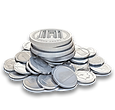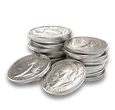🪙 What Is a Metal Premium? Why You Pay More Than Spot Price for Gold & Silver (Explained for Real Buyers)
- GoldsilverJapan

- Aug 23
- 4 min read
If you’ve ever looked at the spot price of gold or silver—then tried to actually buy it—you’ve probably wondered:
💬 “Why is this coin way more expensive than the market price I see online?”
That extra amount you pay is called the metal premium—and understanding it is crucial if you want to be a smart investor or stacker.
In this article, we’ll break down exactly what a premium is, why it exists, how it’s calculated, and how to avoid overpaying. We’ll also cover major mistakes to avoid and clarify how your investment goal changes the kind of metal you should be buying.
🔍 What Is a Metal Premium?
The metal premium is the amount you pay above the spot price to acquire a physical precious metal product like a coin, bar, or round.
🧮 Example:
Spot price of silver: $25/oz
Dealer price for a 1 oz coin: $32
Metal premium: $7
Formula:👉 Final Price = Spot Price + Premium
✅ Why Does a Premium Exist?
A premium isn't a scam—it's the natural cost of getting physical metal from mine to mint to market.
Key factors driving premiums:
Manufacturing Costs
Mints charge for refining, striking, and packaging the product.
Proof and high-relief coins cost even more to produce.
Brand & Mint Reputation
Government-issued coins (like American Eagles or Canadian Maples) carry higher premiums.
Well-known private mints (e.g., PAMP, Valcambi) also have brand-based costs.
Dealer Markup
Retailers include profit margins to cover operations and logistics.
Supply & Demand
During high-demand periods (crises, inflation spikes), premiums can surge.
Some coins are always in higher demand due to popularity or scarcity.
Product Type & Size
1 oz coins have higher premiums per ounce than 100 oz bars.
Fractional coins (1/10 oz, 1/4 oz) often have the highest premium per gram.
⚖️ Does Weight Affect Premiums?
Yes—significantly. Larger bars typically have much lower premiums per ounce.
🧠 Pro tip: If you're stacking for long-term savings and want the most silver for your money, 100 oz bars offer great value.But remember: when you want to sell, you can't just shave off a piece—you'll need to offload the whole bar.
🎯 Know Your Goal: Are You a Stacker or a Collector?
One of the biggest mistakes new buyers make is not clearly defining their goal before purchasing.
If you’re a stacker:
You want low-premium, liquid bullion. Your goal is wealth preservation and metal weight at the lowest possible cost.
Avoid:
Proof coins
Reverse proof coins
Limited-edition themed coins (e.g., Disney, Star Wars, Marvel, James Bond)
These are called semi-numismatics—they have high premiums and are sold more for collectability than intrinsic metal value.
❗ Many of these coins lose resale value because they’re only desirable to niche collectors—not bullion investors.
If you're a collector or numismatist:
You may enjoy the history, rarity, and aesthetic value of coins. That’s fine—but know that your investment is no longer purely about metal price.
Numismatic and proof coins:
Have value based on rarity or history, not spot price.
Require specialized knowledge to value and resell.
Are generally not recommended for stackers or first-time investors.
💬 Common Questions People Ask (And the Honest Answers)
Q1: Can I avoid paying a premium?
Not entirely. But you can minimize it:
Buy large-format bars (e.g., 100g, 1kg, 100 oz)
Choose generic rounds or bars instead of government coins
Shop around different dealers—online often has better pricing than local shops
Q2: Do I get the premium back when I sell?
Sometimes. Popular coins (like American Silver Eagles) retain part of the premium. Generic bars often do not.
Q3: Are semi-numismatic coins a good investment?
Not for stackers. They carry high premiums and are harder to resell unless you find a collector. Stick to standard bullion if you're buying for value, not art.
Q4: How much is a “normal” premium?
⚠️ These change depending on market conditions, brand, and region.
📈 What Causes Premiums to Spike?
You might notice huge premiums during global economic stress. Here's why:
📉 Falling spot prices (dealers keep premiums high to cover costs)
🧊 Supply chain delays
📦 Refinery backlogs or mint closures
🌍 Geopolitical risk or war
😱 Fear-driven buying from retail investors
During the 2020 pandemic panic, silver premiums hit +50% in some cases!
🧠 Final Tips for Smart Buyers
✅ Clarify your goal: Am I stacking or collecting?
✅ Compare premiums before buying—not just spot price
✅ Avoid proof/semi-numismatic coins unless you're a collector
✅ Go big (100 oz bars) if you're in it for long-term savings—but know the tradeoffs
✅ Understand resale: ask your dealer how they buy back before you buy
🏁 Final Thoughts: Premiums Matter—But So Does Your Strategy
The metal premium isn’t just a fee—it reflects the real-world cost of turning metal into money. Whether you’re stacking for security or collecting for joy, understanding premiums helps you:
Buy smarter
Pay less per ounce
Avoid hype and high-markup traps
👉 Bottom line: Know why you're buying, and the “how much” will make more sense.











Comments